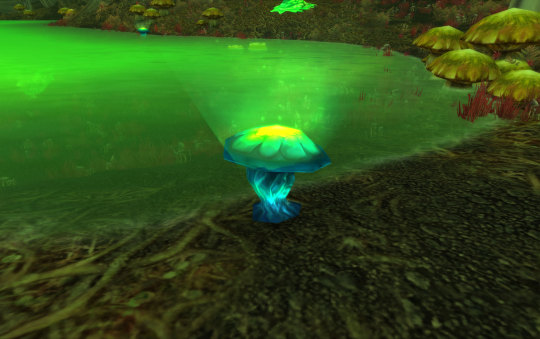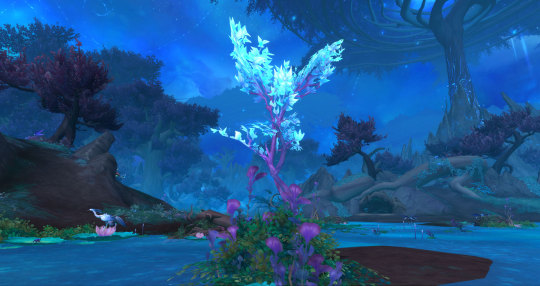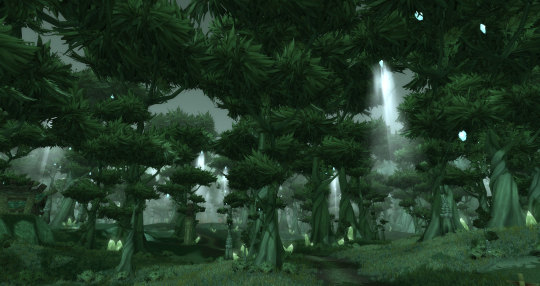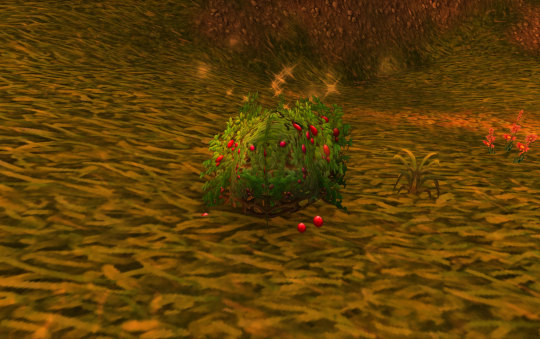#magicalplants

As with many things in the Shadowlands, Adrima’s lilies rely on ambient anima in the environment to survive. Though this plant appears delicate at first glance, its ability to extract and survive off untapped anima deep in the ground makes it remarkably resilient and, consequently, a highly valuable source of anima amid the ongoing drought [Quest: The Cycle of Anima: Adrima’s Lily]. With little else to safely glean the lifegiving substance from these days, the Kyrian have taken to harvesting Adrima’s lilies to supplement their anima stores. Many stewards also collect the flower, though it is more for their fragrance and beauty than any apparent usefulness [Quest: The Cycle of Anima: Flower Power].
It may be worth pointing out that Adrima’s lilies share many similarities with aethril, a plant endemic to Azeroth. Both species are notable for drawing magical substances from their environment for nutrients, though aethril subsists on ley energy rather than anima [Quest: Aethril Sample]. The flowers differ in how they store magic, however. Aethril’s reproductive filaments typically contain more magical energy than the rest of the plant, whereas much of the anima taken in by the lily is stored in its bulb [Quest: Spayed by the Spade,Quest: The Cycle of Anima: Flower Power].
While this flower appears to be named for someone called “Adrima,” none of the local Kyrian or stewards seem to know who they are [Quest: The Cycle of Anima: Flower Power].
The scent of dried Adrima’s lilies is known to enhance mindfulness [Item: Adrima’s Potpourri].

Given that emerald shimmercaps grow in Felwood, it is little surprise that the average passerby mistakes their bright green hue for demonic corruption. In truth, their color has nothing to do with fel magic. These mushrooms get their distinctive appearance – and likely their name – from their connection to the Emerald Dream [Quest: A Slimy Situation].
In stark contrast to much of Felwood’s native flora, this species of fungi remains untainted by demonic forces in the region. While one may infer it is their tie to the Dream that prevents these mushrooms from succumbing to fel influence, the full explanation is a bit more nuanced – emerald shimmercaps have the unique ability to purify corruption [Quest: A Slimy Situation].
It makes sense, then, why many of these mushrooms are typically found near pools of fel-tainted water [Quest: A Slimy Situation]. By cleansing water sources in the region, this species of fungi could very well aid in stemming the spread of demonic corruption throughout northern Kalimdor.
Due to their magical nature, emerald shimmercaps are also highly effective at treating infections demonic in origin. When an undead single-handedly transformed the denizens of an outpost into fel slimes, one dryad made a paste from the mushroom that prevented a tauren from mutating along with them [Quest: A Slimy Situation,Quest: The Tainted Ooze].
Because of the Cenarion Circle’s efforts to heal Felwood, it is unclear if this species of fungi was planted deliberately or if it is endemic to the region.

Of Ardenweald’s countless plant species, the culex tree is one of the most highly prized. Found near the Banks of Life on the northern edge of the realm, this tree is easily distinguishable by its pale green leaves [Quest: Gifts of the Forest]. It is the wood, however, wherein the tree’s true value lies [Item: Culexwood Branch].
Culexwood, which is remarkably soft and light, is coveted by the night fae for its many practical applications [Item: Culexwood Branch]. In most cases, it is usually carved into musical instruments or weapons [Item: Culexwood Longbow,Item: Culexwood Dagger,Item: Culexwood Knife]. Musical instruments made from culexwood are considered some of the finest, so much so that they are even offered as prizes in contests of skill and creativity among musicians [Item: Culexwood Pan Flute]. Culexwood is also an integral component of specially made totems used to relocate gormlings. However, it is worth noting the tree must give of its wood willingly for the totem to work [Quest: Gifts of the Forest].

One of the most common plant species found on Outland today is the olemba tree, a conifer that dominates much of Terokkar Forest’s ecosystem [Item: Greatmother’s List of Herbs].
The olemba tree stores its seeds in tough, fist-sized cones that, once they reach maturity, fall from the branches of the tree [Quest: Olemba Seeds,Item: Olemba Seed]. The seeds themselves are exceptionally oily and can be pressed into a high-quality mana oil [Quest: And Now, the Moment of Truth].

Hapless adventurers were once tricked by Greatmother Geyah into believing that olemba tree roots were a key ingredient in an elixir that would allow them to see and commune with the spirits of the dead [Quest: Material Components]. As it turns out, however, the potion was merely a test of the adventurers’ dedication and actually had no real effects whatsoever [Quest: To Meet Mother Kashur].

Some plant species only bloom during the Lunar Festival, a two-week-long celebration commemorating the Burning Legion’s defeat during the War of the Ancients 10,000 years ago [Page: Lunar Festival,Quest: Elune’s Blessing, Quest: Crown of Good Fortune]. According to popular belief, each of the short-lived flowers has a special connection to the moon goddess, Elune [Quest: Crown of Dark Blossoms]. One of them, the flower of luck, is even thought to be a favorite of hers [Quest: Crown of Good Fortune].
Though it only blooms for a brief time, the flower of luck normally grows in southern Dun Morogh [Quest: Crown of Good Fortune].
Lunar Festival celebrants traditionally weave the flower of luck and other blossoms into flower crowns to wear during the holiday [Quest: Crown of Good Fortune,Item: Crown of Everlasting Fortune].

The bloodberry bush is a wild plant that grows all over Azeroth. Although it is usually considered something of a nuisance wherever it sprouts, the bush’s berries are coveted by both chefs and alchemists [Quest: Open for Business]. Most commonly, chefs use bloodberries as a key ingredient in some culinary delicacies, the most famous of which is the bloodberry tart [Item: Bloodberry Tart, World of Warcraft: The Official Cookbook, pg. 149]. Alchemists, however, like to use bloodberries – specifically, a unique type of bloodberry native to the Isle of Quel’Danas – for another reason. When exposed to the energies of the Sunwell, the plant develops special properties that can then be distilled and made into an elixir that magnifies one’s abilities [Quest: Open for Business,Item: Bloodberry Elixir].
